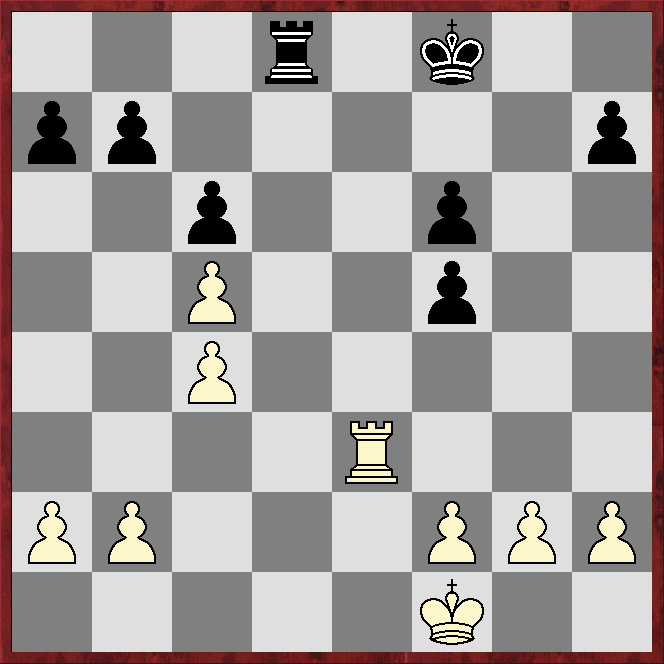Spanton (1824) - Jiří Plešek (2005)
Caro-Kann Tartakower
1.e4 c6 2.d4 d5 3.Nc3 dxe4 4.Nxe4 Nf6 5.Nxf6+ exf6 6.Be3!?
There are 410 examples of this move in ChessBase's 2023 Mega database, including being played by Ian Nepomniachtchi, Wesley So and Michael Adams, but the text is a lot less popular than 6.Bc4, 6.Nf3 and especially 6.c3.
*****
*****
*****
*****
6...Bd6
This is easily the most popular move in Mega23, but Komodo14.1 marginally prefers 6...Qb6!?, trying to take immediate advantage of White's last move. After the main continuation 7.Qc1 Bd6 8.Bd3 0-0 Komodo14.1 gives White a slight edge, but Stockfish15.1, which does not suggest 6...Qb6!?, calls the position equal.
7.Bd3 0-0 8.Ne2 Re8 9.0-0 Nd7 10.Ng3
So has twice played 10.c4 Nf8 11.Ng3 in wins over 2600+ opponents.
10...g6 11.Ne4!?
This may be a novelty. It comes to be Komodo14.1's top choice, although Stockfish15.1 prefers the known move 11.Re1.
11...Bf8!?
The engines prefer this and 11...Be7 to staying on the b8-h2 diagonal with 11...Bb8 or 11...Bc7.
12.Bf4
The engines suggest 12.c4 f5 13.Nc3, and if 13...Nf6 then 14.Be2!?, but agree the position is equal.
12...f5 13.Nd6 Re6
Komodo14.1 suggests grabbing a pawn with 13...Bxd6!? 14.Bxd6 Nf6 15.Bb4 Qxd4 16.Bc3 Qd6, but accepts White has full compensation.
*****
*****
*****
*****
Probably not, although there are two lines worth investigating.
A) 14.Nxf7?! Kxf7 15.Bc4 seems to fail to 15...Nf6 16.Bxe6+ Bxe6, when White's rook and pawn are unlikely to be enough for Black's bishop and knight, especially as Black also has a useful-looking bishop-pair, and the black king is safe.
B) 14.Nxf5?! gxf5 15.Bxf5 Re8 (15...Re7 may be fine too) 16.Qg4+ (Komodo14.1 at first reckons this gives equal chances, but that is almost certainly not the case) Kh8, and there does not seem to be a convincing continuation for White, eg 17.Bg5 Be7 18.Qh5 is answered by 18...Nf8.
14.Nxc8 Rxc8
*****
*****
*****
*****
White has the bishop-pair and better pawn-structure, but according to the engines the position is completely equal. I guess the point is the position is not one in which the white bishops have great scope, and meanwhile the knight has promising squares at e4 and d5.
15.Re1!?
More circumspect is 15.c3.
15...Rxe1+ 16.Qxe1 Bg7
Black can hit two unprotected pawns with 16...Qb6, when 17.Qc3 is an awkward defence, eg 17...Bg7 18.Be5 Bxe5!? 19.dxe5 Nc5!? 20.Re1 Rd8, after which Komodo14.1 gives Black a slight edge although Stockfish15.1 calls the game equal.
Also interesting is 17.c3!?, eg 17...Qxb2 18.Rb1 Qxa2 19.Rxb7, when again Komodo14.1 gives Black a slight edge but Stockfish15.1 reckons White has good compensation for a pawn. However the engines suggest meeting 17.c3!? with 17...c5!?, eg 18.d5 c4 19.Bf1 Nf6 20.Be3 Bc5 21.Bxc5, when it is not clear which recapture is better, and again the engines do not agree on their evaluation of the resulting positions.
17.c3 Nc5?
JP said afterwards that immediately on playing this move he saw what was wrong with it.
18.Bxf5 gxf5 19.dxc5 Qe8 20.Kf1 Bf8 21.Bd6 Qxe1+ 22.Rxe1 f6!? 23.c4 Kf7 24.Re3 Rd8 25.Bxf8 Kxf8
*****
*****
*****
*****
White's extra pawn is part of a majority that cannot make a passer with normal play. Black's bigger problem, I believe, is that there are three isolanis, two of which are doubled. The engines agree White is winning.
26.Ke2 Rd4 27.b3 Kf7 28.Rh3 Kg6 29.Rd3
*****
*****
*****
*****
The short answer seems to be No, eg 29...Rxd3?! 30.Kxd3 Kg5 31.Ke3 a6 32.Kf3 a5 33.h4+! etc.
29...Re4+ 30.Re3 Re5
Allowing an exchange on e4 is hopeless, eg 30...Kg5 31.Rxe4 fxe4 32.Ke3 f5 33.Kd4 Kf6 34.b4 Ke6 35.Ke3 Ke5 36.g3 a6 37.a3 h5 38.h4 Ke6 39.Kf4 Kf6 40.a4 etc.
31.Kd3!?
Also winning easily enough is 31.b4.
31...Rxc5
Or 31...Kf7 32.Kd4 Ke6 33.b4, eg 33...a6 34.g3 h6 35.f4!? Rxe3 36.Kxe3 Kd7 37.Kd4 Kd7 38.Kc3 Kc7 39.Kb3 Kb8 40.Ka4 Kc7 41.Ka5 Kc8 42.Kb6 Kb8 43.a4 Kc8 44.b5 etc.
32.Re7 Ra5
Perhaps 32...Re5!?, going for counterplay, gives better practical chances in the sense White could be panicked into trying to defend the white kingside. However the engines are not keen, and objectively it is pretty hopeless. One line runs 33.Rxb7 Re1 34.Rxa7 Rg1 35.Ra8 Kg7 36.g3 Rg2 37.a4 Rxf2 38.b4 Rxh2 39.b5 cxb5 40.axb5, after which the queenside pawns cannot be stopped.
33.a4 b6 34.Rc7 b5!?
Or 34...c5 35.Ke3 Kg5 36.h4+!
35.axb5 cxb5 36.c5
This pawn cannot be stopped.
The game finished:
36...Ra3 37.Kc3 a5 38.Kb2 b4 39.Ra7 1-0





No comments:
Post a Comment